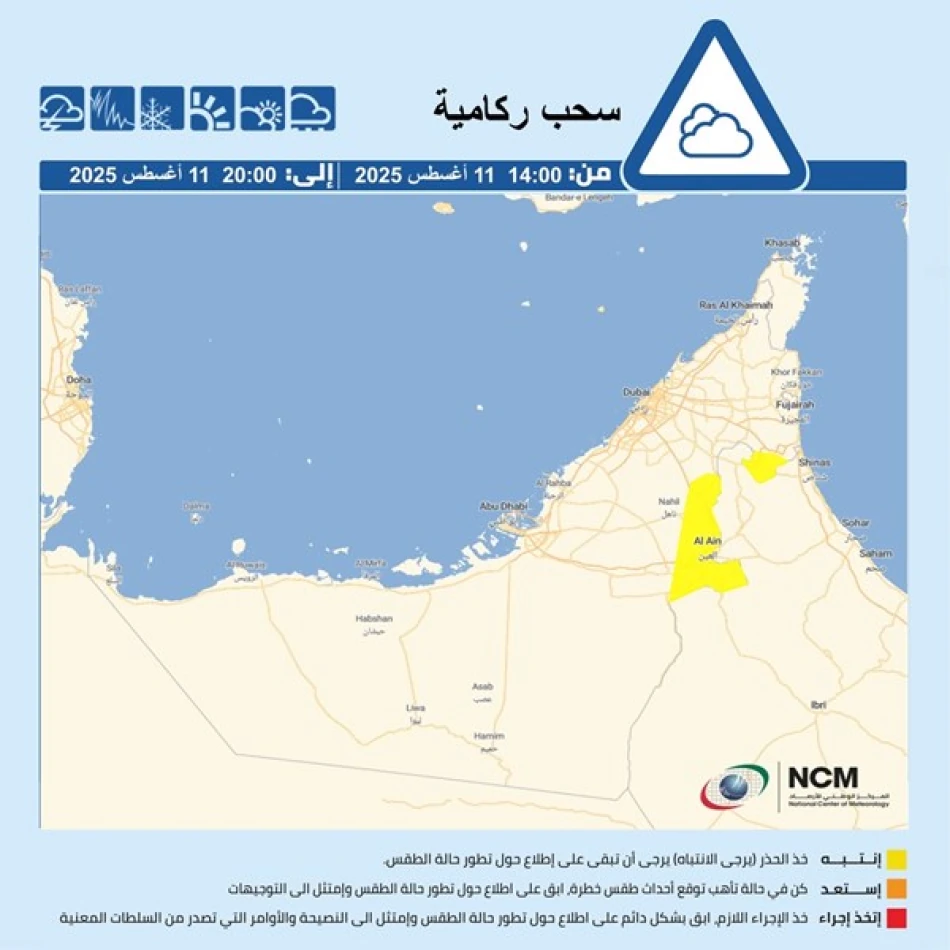
Brace for Thunderstorm Showers: Meteorological Agency Forecasts Chance of Cumulonimbus Clouds
Saudi Arabia Braces for Severe Weather as Dust Storms and Heavy Rain Target Eastern Regions
Saudi Arabia's eastern provinces are preparing for a powerful weather system that threatens to disrupt daily life and economic activity on Monday, with meteorologists warning of dangerous conditions including torrential rain, fierce winds reaching 45 km/h, and visibility-reducing dust storms. The six-hour weather event highlights the Kingdom's increasing vulnerability to extreme weather patterns that could impact its crucial oil infrastructure and urban centers.
Weather Alert: Six Hours of Severe Conditions Expected
The National Center of Meteorology has issued warnings for cumulonimbus cloud formation across Saudi Arabia's eastern regions, with severe weather conditions expected between 2:00 PM and 8:00 PM on Monday, August 11, 2025. The forecast predicts a dangerous combination of heavy rainfall, strong winds, and dust storms that could significantly reduce horizontal visibility.
Wind speeds are expected to reach up to 45 kilometers per hour, creating hazardous driving conditions and potentially disrupting air travel. The intensity of the dust and debris stirred by these winds poses particular risks for the region's extensive highway network and could force temporary closures of key transportation routes.
Economic Implications for the Kingdom's Energy Hub
Oil Infrastructure at Risk
The eastern region houses Saudi Arabia's most critical oil production facilities, including the world's largest conventional oil field, Ghawar, and the massive Safaniya offshore field. While Saudi Aramco's facilities are designed to withstand harsh weather conditions, severe dust storms can still impact operations through reduced visibility for helicopter transfers to offshore platforms and potential delays in maintenance activities.
The timing of this weather event is particularly significant as global oil markets remain sensitive to any disruptions in Saudi production. Even minor operational delays in the Kingdom can influence international crude prices, given Saudi Arabia's position as the world's largest oil exporter.
Port Operations and Logistics Challenges
The eastern region's major ports, including Dammam and Jubail, serve as crucial gateways for both oil exports and imports of consumer goods. Strong winds and reduced visibility could force temporary suspensions of loading operations, potentially creating ripple effects throughout regional supply chains.
Regional Weather Patterns and Climate Context
This severe weather event reflects broader patterns affecting the Arabian Peninsula, where climate change is intensifying both drought conditions and extreme precipitation events. The formation of cumulonimbus clouds in typically arid regions signals the kind of volatile weather systems that are becoming more frequent across the Middle East.
Similar dust storm events have previously caused significant disruptions across the Gulf region. In 2022, a massive dust storm affected multiple countries including Saudi Arabia, Iraq, and Iran, grounding flights and forcing thousands to seek medical treatment for respiratory issues. The economic cost of such events extends beyond immediate disruptions to include healthcare expenses and long-term infrastructure maintenance.
Preparedness and Safety Measures
Saudi authorities are likely implementing standard severe weather protocols, including potential restrictions on outdoor activities and advisories for residents to secure loose objects that could become projectiles in high winds. The Kingdom's experience with previous dust storms has led to improved early warning systems and emergency response procedures.
For businesses operating in the region, this weather event serves as a reminder of the importance of robust contingency planning. Companies with significant exposure to Saudi Arabia's eastern provinces should monitor conditions closely and prepare for potential supply chain disruptions that could extend beyond the immediate six-hour window of severe weather.
The concentration of severe weather conditions into a relatively short timeframe may actually minimize long-term disruptions compared to extended periods of moderate adverse conditions, but the intensity of the predicted winds and dust storms requires immediate attention from both authorities and residents in the affected areas.
Most Viewed News

 Layla Al Mansoori
Layla Al Mansoori






